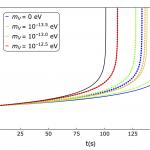Paper of the month: Imprints of the Dark Sector in Gravitational Waves

November 24, 2017 by tiinatimonen
LIGO and Virgo are experiments designed to detect GWs by very precisely measuring the distance between two points in spacetime. In 2015 the LIGO experiment reported the first direct detection of GWs [1] coming from two merging black holes. As the experimental program continues, LIGO and Virgo detectors are looking for gravitational signals from more objects in the sky, and recently they observed GWs from the collision between two neutron stars [2].
This recent observation opens up new possibilities to use GWs as a new handle on observing physical phenomenon in the Universe. For instance, very little information about dark matter (DM) on the particle level is currently known. Does DM interact with itself via a “dark force”?
Measuring GWs from neutron star mergers might be a way to answer this question. Recently, it was proposed [3] that GWs produced in neutron star mergers can probe for the existence of a dark force-carrying particle, the dark photon. The interaction of the hidden sector with the neutron stars would affect the time dependence of the frequency f(t) of GWs in such a way that cannot be fitted by pure gravity. Since f(t) depends on the “chirp mass” of the system, which is a function of the neutron star masses, a shift in the frequency will be translated into a change in the binary mass.
If the dark photon mass (m) lies within the LIGO band of (10−13,10−11) eV, and when the binary separation r<<1/m, a dark photon would create noticeable corrections to f(t).
These corrections can come from two major effects. The first effect is a repulsion from the exchange of dark photons between the two neutron stars. When binary separation reduces below 1/m, the repulsion becomes significant, and the dark photon changes the f(t). This change would look like if the chirp mass suddenly got smaller until the stars collided. This characteristic shift in the chirp mass would be a smoking-gun signal for a ultralight mediator causing the repulsion between the two stars. This effect is shown by the solid lines in the figure below.
If there is a dark photon force, then DM is charged under this force. The second major effect on f(t) comes from the DM charge. If the two neutron stars have different charge-mass ratios, when they start to spiral towards each other they will have a characteristic dark dipole moment and energy will be carried away from the system. As a result, the f(t) would change according to the dotted lines shown in the figure below.
If a search for shifts in chirp mass or dipole radiation components is incorporated into the LIGO and Virgo analysis, these experiments could set bounds on the coupling constants for dark force carrier particles of certain masses. This means LIGO and Virgo have the potential to be observational probes in the particle nature of dark matter.

FIG. 1: The black line shows f(t) in the case of no dark photon effects on the neutron star merger. The colored solid lines show the same frequency-time dependence in the case that the dark photon Yukawa potential is affecting the merger, and the dark radiation is zero. The colored dotted lines show the case where both the Yukawa potential and the dark radiation from the dark photon are affecting the neutron star merger. The colors mean different masses m for the dark photon. Figure taken from [3].
Text by Josu Hernández García and Rachel Houtz
[1] B. P. Abbott et al. [LIGO Scientific and Virgo Collaborations], Phys. Rev. Lett. 116 (2016) no.6, 061102 [arXiv:1602.03837 [gr-qc]].
[2] B. P. Abbott et al. [LIGO Scientific and Virgo Collaborations], Phys. Rev. Lett. 119 (2017) no.16, 161101 [arXiv:1710.05832 [gr-qc]].
[3] D. Croon, A. E. Nelson, C. Sun, D. G. E. Walker and Z. Z. Xianyu, arXiv:1711.02096 [hep-ph].


